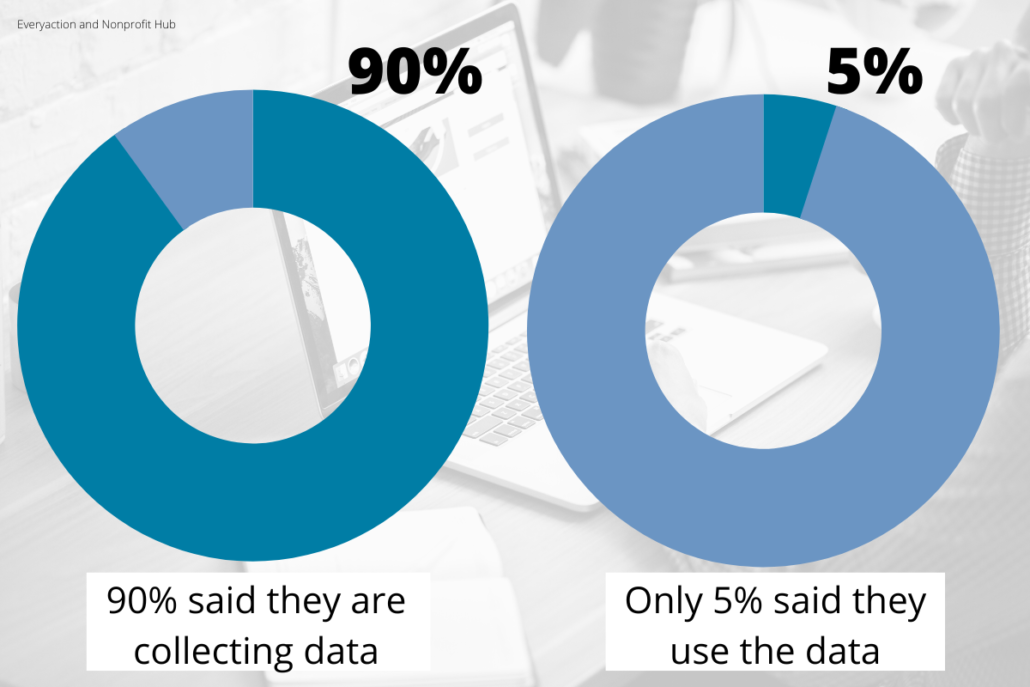That’s a bold statement: “empower your communications through data management.”
After all, data management is the process of organizing and structuring data in a way that it is easily searchable and useable.
While it isn’t always the most interesting task of an individual’s job, it is very important to format your data so that you have easy access to it. Although you use data management for any type of data, it’s mostly used for structured data.
One example of structured data would be donor information, such as names, addresses, and emails, as well as giving history. You can also use data management for unstructured data like videos or photos. But what does managing your data have to do with your communications?

In a 2019 survey, Everyaction and Nonprofit Hub found that 90% of their respondents collect data. However, only 5% said they are using the data. So you’re collecting all this data. What can you do with it?
How to Affect Fundraising Communications with Data Management
How you manage your data affects your fundraising in a variety of ways. The data you collect helps to design strategies and, ultimately, communications.
Your data management strategy is the key to a successful nonprofit communications strategy. Each nonprofit should have a data strategy in place to make sure that they are collecting the right data and using it effectively to reach their goals. In order to reach your goals, you need to manage all the aspects of your data.
More and more nonprofit organizations recognize the importance of managing their data. They realize this critical information provides an opportunity for them to innovate and improve upon their communications. In addition, nonprofits can use data to create a better donor experience, potentially increasing donations.
This isn’t just about keeping track of the data, it also includes knowing how to use it.
What data do you need to collect in order to be successful?
There are many ways to collect, analyze and act on data that are relevant for your communications.
Before you can manage your data, you need to collect it. Using social media, direct mail, or landing pages is a great start.
What Types of Data Should You Collect?
Data collection is the first step in any data management process. To collect data, you need to know what information you want, where to find it and how to organize it. Once you collect that information, you can use it to track trends and, of course, for your communications.
Some data that you should collect and manage for your nonprofit communications are:
-
-
Demographic data (gender, age, ethnicity)
-
Geographic data (state, region)
-
Behavioral data (online behavior, engagement with social media)
-
Transaction data (donations, memberships)
-
Interest data (clubs, sports teams, participation at events)
-
How To Use Your Collected Data
Now you can use your data for a variety of purposes. Data is the one asset that you can use to maximize your marketing efforts. To put your data into action, you can use it for direct mail, email, digital ads, or web design.
Direct mail: Direct mail takes your provided data using variable printing. It goes way beyond personalization. All of that demographic, geographic, behavioural, transactional, and interest data can now intertwine throughout the copy and imagery.
Email: You can send trigger emails based on behavioural data. This is an efficient way to reach out to your donors while you are top of mind. Tease your donors with a story via email and drive your donors to your donation page or your website.
Digital ads: Digital ads are an excellent way of reaching out to people who are on the go and have their attention focused on their phones or tablets. You can use them to target previous visitors from your website or your social media. You can even serve up ads to your direct mail list!
Website: You can personalize your website based on the data you collect from your donors and the content they are interested in. This will help make sure that your website stays relevant to them and that you continue to engage them with the content they want.
Conclusion: Time to Power Up Your Communications
The data that you collect from your donors is critical to the growth of your organization. You can increase donations, manage the donor relationship, and create a more personalized experience for them. Developing a strategy around your data management only enhances your communications.
At BCG Connect, we protect your data and use it to provide more effective marketing campaigns. We have several ways to use your data into the creative, copy, and visual elements. If you’d like to know more about how we can help turn your data into powerful communications, get in touch with us.

